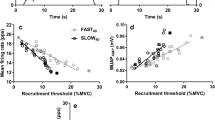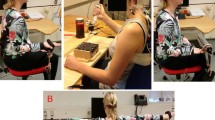Abstract
The aim of the study was to investigate the adaptations of motor unit discharge rate and additional motor unit recruitment in different regions of the upper trapezius muscle during sustained contraction. Intramuscular EMG signals were recorded from three locations (cranial, middle, and caudal) within the upper trapezius of eleven healthy men during 60-s static shoulder abduction at 25% of the maximal force. Surface EMG signals were recorded concurrently with a 10 × 5 electrode grid. Fifty-one (cranial location), 39 (middle), and 19 (caudal) motor units were identified from the intramuscular EMG signals. Motor unit discharge rates at the beginning of the contraction were greater in the caudal than in the other two locations (cranial: 16.5 ± 3.4 pps; n = 28, middle: 16.2 ± 3.4 pps; n = 32, caudal: 19.6 ± 3.1 pps; n = 13; P < 0.05). Because the decrease in discharge rate over time was larger for the caudal location, at the end of the contraction the discharge rates were comparable at all locations (cranial: 15.7 ± 3.3 pps; n = 28, middle: 14.9 ± 2.3 pps; n = 32, caudal: 15.8 ± 3.6 pps; n = 13). Additional motor unit recruitment was observed in all locations but more frequently in the caudal region (19 motor units recruited after the beginning of the contraction vs. only 4 in each of the other two locations). The mean position of the distribution of surface EMG amplitude over the grid moved by 1.4 ± 0.7 mm (P < 0.001) in the cranial direction at the end with respect to the beginning of the contraction. The results showed that the neural drive received by the upper trapezius depends on the muscle region, which may indicate non-uniform descending drive to the motor neuron pool.





Similar content being viewed by others
References
Bawa P, Pang MY, Olesen KA, Calancie B (2006) Rotation of motoneurons during prolonged isometric contractions in humans. J Neurophysiol 96:1135–1140
Bigland-Ritchie BR, Dawson NJ, Johansson RS, Lippold OC (1986) Reflex origin for the slowing of motoneurone firing rates in fatigue of human voluntary contractions. J Physiol 379:451–459
Blanksma NG, Van Eijden TM, Weijs WA (1992) Electromyographic heterogeneity in the human masseter muscle. J Dent Res 71:47–52
De Luca CJ, Foley PJ, Erim Z (1996) Motor unit control properties in constant-force isometric contractions. J Neurophysiol 76:1503–1516
Falla D, Farina D (2007) Periodic increases in force during sustained contraction reduce fatigue and facilitate spatial redistribution of trapezius muscle activity. Exp Brain Res 182:99–107
Falla D, Farina D (2008) Motor units in cranial and caudal regions of the upper trapezius muscle have different discharge rates during brief static contractions. Acta Physiol (Oxf) 192:551–558
Fallentin N, Jorgensen K, Simonsen EB (1993) Motor unit recruitment during prolonged isometric contractions. Eur J Appl Physiol Occup Physiol 67:335–341
Farina D, Leclerc F, Arendt-Nielsen L, Buttelli O, Madeleine P (2008) The change in spatial distribution of upper trapezius muscle activity is correlated to contraction duration. J Electromyogr Kinesiol 18:16–25
Farina D, Madeleine P, Graven-Nielsen T, Merletti R, Arendt-Nielsen L (2002) Standardising surface electromyogram recordings for assessment of activity and fatigue in the human upper trapezius muscle. Eur J Appl Physiol 86:469–478
Forbes A (1922) The interpretation of spinal reflexes in terms of present knowledge of nerve conduction. Physiol Rev 2:361–414
Gandevia SC (2001) Spinal and supraspinal factors in human muscle fatigue. Physiol Rev 81:1725–1789
Garland SJ, Enoka RM, Serrano LP, Robinson GA (1994) Behavior of motor units in human biceps brachii during a submaximal fatiguing contraction. J Appl Physiol 76:2411–2419
Hermans V, Spaepen AJ (1997) Influence of electrode position on changes in electromyograph parameters of the upper trapezius muscle during submaximal sustained contractions. Eur J Appl Physiol 75:319–325
Holtermann A, Roeleveld K (2006) EMG amplitude distribution changes over the upper trapezius muscle are similar in sustained and ramp contractions. Acta Physiol 186:159–168
Jensen C, Westgaard RH (1995) Functional subdivision of the upper trapezius muscle during maximal isometric contraction. J Electromyogr Kinesiol 5:227–237
Jensen C, Westgaard RH (1997) Functional subdivision of the upper trapezius muscle during low-level activation. Eur J Appl Physiol 76:335–339
Lindman R, Eriksson A, Thornell LE (1990) Fiber type composition of the human male trapezius muscle: enzyme-histochemical characteristics. Am J Anat 189:236–244
Macefield G, Hagbarth KE, Gorman R, Gandevia SC, Burke D (1991) Decline in spindle support to a-motoneurones during sustained voluntary contractions. J Physiol 440:497–512
Madeleine P, Leclerc F, Arendt-Nielsen L, Ravier P, Farina D (2006) Experimental muscle pain changes the spatial distribution of upper trapezius muscle activity during sustained contraction. Clin Neurophysiol 117:2436–2445
Marsden CD, Meadows JC, Merton PA (1983) “Muscular wisdom” that minimizes fatigue during prolonged effort in man: peak rates of motoneuron discharge and slowing of discharge during fatigue. Adv Neurol 39:169–211
Mathiassen SE (1993) The influence of exercise/rest schedule on the physiological and psychophysical response to isometric shoulder-neck exercise. Eur J Appl Physiol Occup Physiol 67:528–539
Mathiassen SE, Aminoff T (1997) Motor control and cardiovascular responses during isoelectric contractions of the upper trapezius muscle: evidence for individual adaptation strategies. Eur J Appl Physiol Occup Physiol 76:434–444
Mathiassen SE, Winkel J (1990) Electromyographic activity in the shoulder-neck region according to arm position and glenohumeral torque. Eur J Appl Physiol Occup Physiol 61:370–379
Mathiassen SE, Winkel J (1996) Physiologic comparison of three interventions in light assembly work: reduced work pace, increased break allowance and shortened working days. Int ArchOccup Environ Health 68:94–108
McGill KC, Lateva ZC, Marateb HR (2005) EMGLAB: an interactive EMG decomposition program. J Neurosci Meth 149:121–133
Merletti R, Knaflitz M, De Luca CJ (1990) Myoelectric manifestations of fatigue in voluntary and electrically elicited contractions. J Appl Physiol 69:1810–1820
Monster AW, Chan H (1977) Isometric force production by motor units of extensor digitorum communis muscle in man. J Neurophysiol 40:1432–1443
Nordstrom MA, Gorman RB, Laouris Y, Spielmann JM, Stuart DG (2007) Does motoneuron adaptation contribute to muscle fatigue? Muscle Nerve 35:135–158
Paton ME, Brown JM (1994) An electromyographic analysis of functional di€erentiation in human pectoralis major muscle. J Electromyogr Kinesiol 4:161–169
Paton ME, Brown JM (1995) Functional differentiation within latissimus dorsi. Electromyogr Clin Neurophysiol 35:301–309
Person RS, Kudina LP (1972) Discharge frequency and discharge pattern of human motor units during voluntary contraction of muscle. Electroenceph Clin Neurophysiol 32:471–483
Shiozaki K, Abe S, Agematsu H, Mitarashi S, Sakiyama K, Hashimoto M, Ide Y (2007) Anatomical study of accessory nerve innervation relating to functional neck dissection. J Oral Maxillofac Surg 65:22–29
ter Haar Romeny BM, Denier van der Gon JJ, Gielen CC (1982) Changes in recruitment order of motor units in the human biceps muscle. Exp Neurol 78:360–368
ter Haar Romeny BM, Denier van der Gon JJ, Gielen CC (1984) Relation between location of a motor unit in the human biceps brachii and its critical firing levels for different tasks. Exp Neurol 85:631–650
Westad C, Westgaard RH, De Luca CJ (2003) Motor unit recruitment and derecruitment induced by brief increase in contraction amplitude of the human trapezius muscle. J Physiol 552:645–656
Westgaard RH, De Luca CJ (1999) Motor unit substitution in long-duration contractions of the human trapezius muscle. J Neurophysiol 82:501–504
Wolf SL, Segal RL, English AW (1993) Task-oriented EMG activity recorded from partitions in human lateral gastrocnemius muscle. J Electromyogr Kinesiol 3:87–94
Acknowledgments
Deborah Falla is supported by the National Health and Medical Research Council of Australia (ID 351678). This study was partly supported by the Danish Technical Research Council (project “Centre for Neuroengineering (CEN),” contract no. 26-04-0100) (Dario Farina).
Author information
Authors and Affiliations
Corresponding author
Rights and permissions
About this article
Cite this article
Falla, D., Farina, D. Non-uniform adaptation of motor unit discharge rates during sustained static contraction of the upper trapezius muscle. Exp Brain Res 191, 363–370 (2008). https://doi.org/10.1007/s00221-008-1530-6
Received:
Accepted:
Published:
Issue Date:
DOI: https://doi.org/10.1007/s00221-008-1530-6




